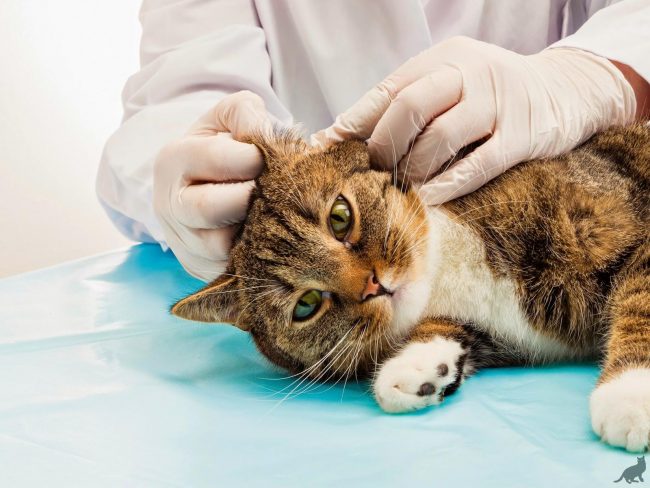
Can I clean my cat’s ears? This is done in certain cases, or should you clean up regularly?
Such questions often come to mind for people new to feline anatomy.
The ears of a cat are an almost perfect organ of perception of sounds and balance adjustment.
The vestibular apparatus located in them allows these animals always land on four legs.
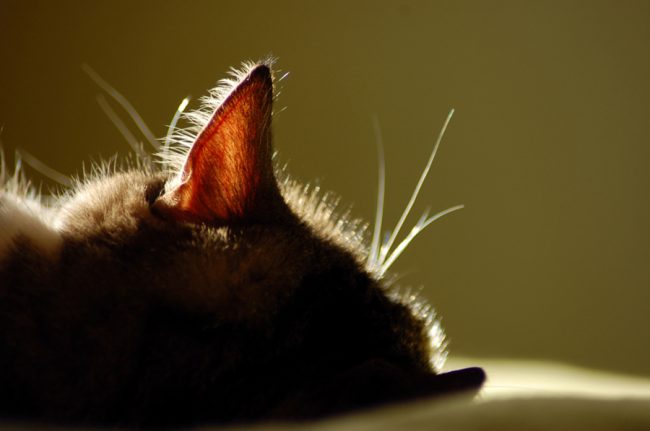
Prompt cleaning is the best way to avoid problems. with ears
If the cat’s ears are dirty, it affects the hearing, since the sulfur accumulated in them forms plugs that interfere with the normal passage of sound waves.
In addition, sulfur plugs press on the eardrum and can provoke deafness of the animal, vomiting and nausea.
In addition, the animal may experience dizziness and various chronic diseases of the hearing organs.
That is why, it’s not only possible to clean these important organs, but and need.
In addition, it is necessary to regularly monitor the health of the ears. a cat.
Content
- 1 Why does a cat have dirty ears?
- 2 How to clean cats ears at home
- 3 Otitis and ear mite in a cat
Why does a cat have dirty ears?
Contents
A cat’s ears can get dirty for various reasons.
Before deciding exactly how best to clean them, you need to establish the cause of contamination.
Important! If the animal has big ears, they will “Collect” much more dust and dirt from the environment with which it is usually pet interacts. But cats with small ears in ears get dirt particles, which then settle on the inside surface of the auricles.
Breeds with big ears include Abyssinian Somali cat oriental cat cat, Devon Rex savannah, maine kun.
When the amount of dirt and dust in the ears reaches a large quantities, the animal activates special glands that in large quantities produce earwax.
Sulfur closes the dirt access to the middle ear of the cat.
This body reaction is absolutely normal and does not requires increased attention.

Savannah cats have very large ears, capable of collecting a lot of dust
Interesting! Sometimes there are times when sulfur the glands produce a large amount of protective sulfur all the time. it most commonly found in cats whose coat is either extremely small, or completely absent.
This trend is observed due to the fact that the hairs, which, in fact, they protect the ears from dirt – they are absent.
Since there is much more sulfur in the ears of cats of these breeds, animals need to be given more attention and cleaned regularly ear passages.
For breeds with a minimum wool cover are such as Don Sphinx Peterbold and the Elf.
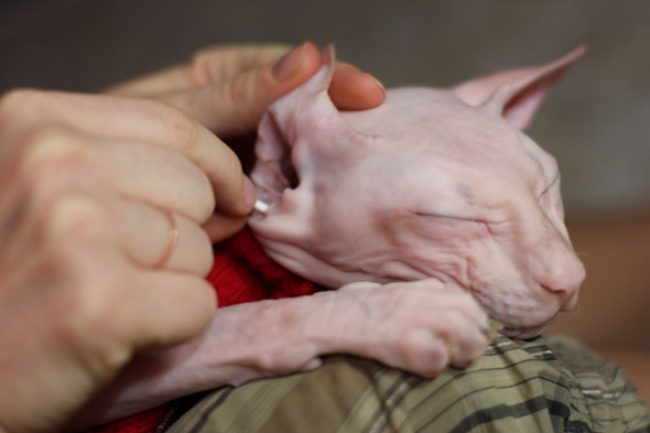
If the cat does not have hair, it emits more earwax
Sometimes cleaning does not give the effect that the owner expects – ears very quickly become polluted, despite regular leaving.
This may indicate a cat’s ear infection. tick, or the presence of chronic otitis media.
In this case, you must show the animal to the veterinarian.
To correctly check the purity of cat ears, they need bend back.
Some are afraid to “turn inside out” the ears of their pets, but this does not cause the animal any discomfort.
The inner wall of the ear should be completely clean.
The owner should pay attention to the following symptoms, which can talk about cat disease:
- Dark deposits;
- Accumulation of dirt;
- Black spots;
- Brown tubercles;
- Combs.
Frequent examination helps identify problems with your ears and in a timely manner. solve them.
For the convenience of checking the ears, you can buy a small flashlight, which will help to look deep into the auricle.
How to clean cats ears at home
How often do you need to clean? It depends on the breed of the animal, state of his health, his age and temperament.
The activity of sulfur glands depends on the breed.
Consequently, breeds that have small ears need to have your ears checked and cleaned once every two weeks.
For example, lop-eared cats can clean their ears once a month.

Cats that are accustomed to ear cleaning this procedure
Veterinarians advise to accustom a cat to ear cleaning from small age, since this process is unpleasant.
An accustomed animal suffers a procedure, and an unaccustomed animal constantly twitches and tries to run away.
To minimize the risk of injury, it is best to clean the ears of an untrained animal together, with one person will clean, and the second – to keep.
It is also recommended that you pre-cut pet claws, or wear anti-scratches, and after the procedure – feed him a treat.
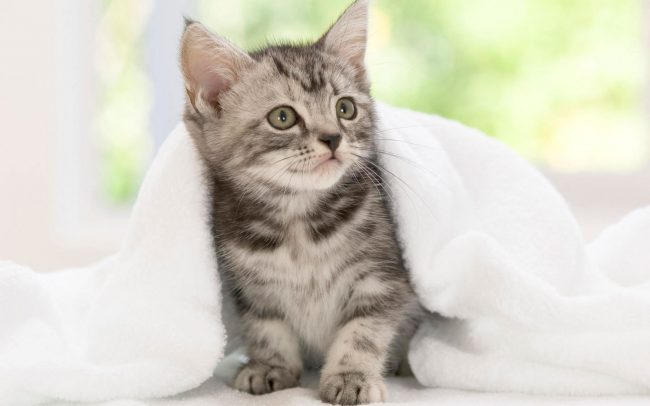
Before cleaning, the cat needs to be fixed with a towel, and pre-cut claws
For proper care of the cat, you need to prepare in advance ear cleaning equipment.
Usually, it consists of the following things:
- Cotton swabs. They will need one or two on each side, if they are clean, or three to four if the ears of the animal are contaminated. Veterinarians prohibit the use of homemade cotton swabs sticks, such as sticks or matches with wound cotton, which can easily scratch the inner surface of the ear shells. Best to use baby cotton buds with limiter.
- Gel for cleaning the ears. Many breeders use for cleaning improvised means, for example, vegetable oil and water. But much it is better to buy a special tool – gel for cleaning cat’s ears. You can also use sterile saline. In no case Do not use alcohol-containing liquids to clean; hydrogen peroxide and ordinary soap, as this will lead to dry skin, sores, increased sulfur production and itching.
- Towel. They need to fix the cat, which may fail moment to jerk or shake your head. Often, sudden movements during cleaning your ears will result in personal injury.
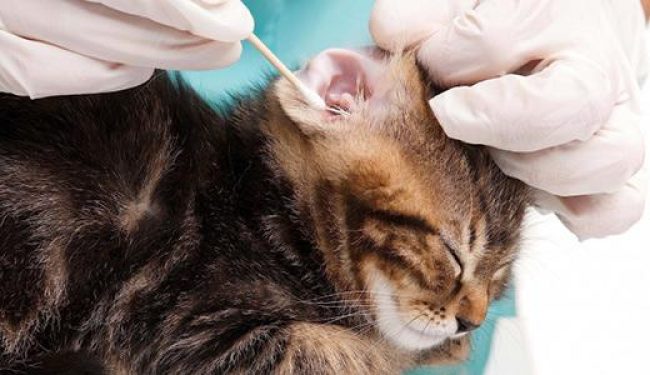
Ears are very sensitive organs that require careful treatment
Whether it’s regular preventative or therapeutic cleaning, all actions should be performed very carefully and slowly, because the ears have the cat is very sensitive.
- To begin with, you need to maximize the ear, bending it to the limit. This will facilitate access to the entire surface of the organ and this speed up the cleaning process.
- A cotton swab needs to be dipped in a gel and rubbed into her ear animal shell. In no case should you squeeze the gel directly inward.
- Immerse a cotton swab in the ear to a depth of about centimeter. Some hosts are afraid to reach the drum membrane and pierce it. But anatomically this is impossible because of her location.
- It’s necessary to perform cleaning with outward movements, and not inside the ear, to clean, not push, dirt.
Otitis and ear mite in a cat
Otitis is a very common disease in cats, its symptoms are often confused with regular ear contamination.
Contrary to popular belief, this ailment is very dangerous and can lead to hearing loss, meningitis and death of the animal.
In fact, this is a bacterial inflammatory process in the auditory animal channel.
There are such types of otitis media:
- Otitis externa;
- Otitis media of the middle ear;
- Otitis media of the inner ear.
Chronic otitis media manifests itself in periodic pain in an animal, which make him nervous and aggressive during exacerbations.
Otitis may be progressive, requiring surgical interventions.
There are several causes of otitis media:
- Injuries
- Fungus;
- Allergy;
- Parasites;
- Infections
Most often, otitis media of the external auditory canal occurs due to the presence of otodectosis in the cat, or an ear mite.
This is a very common feline disease.

The result of an ear mite is a characteristic “dirt” mixed with gray
Usually, an ear mite appears in young cats.
At the same time, in the ears of a sick animal accumulate purulent masses, it is covered with a dark crust.
Since the ears are covered with dark spots from ticks, otodectosis can be identified visually with regular ear checks sinks.
Mites of Ototdectes cynotus cause this disease.
The tick feeds on particles of skin, which causes severe itching in pet.
Otodectosis is transmitted only when one animal comes in contact with to others. Therefore, pets are not at risk.
Also, the ear mite is safe for humans.
Signs of the disease appear quite clearly.
During otodectosis, the cat constantly and forcefully combes its ears, worried and shakes his head.
Sulfur exudes abundantly in the ears.
Due to itching and discomfort, the cat combs his ears and skin near them to bloody scratches.
If the disease is not treated, others develop in the ear canal. bacteria, exacerbating the disease.

Before treatment, the cat must be shown to the veterinarian
Otodectosis is treated quite easily, especially if the disease was detected in a timely manner.
Although this disease is simply diagnosed, it’s better consult with a veterinarian who will give an exhaustive information about the disease itself, its stage and degree of damage.
For the most accurate diagnosis, you need to conduct a study of the ear cat discharge under the microscope.
Only after this, the doctor prescribes treatment.
As a treatment, a veterinarian usually prescribes anti-mite (e.g. Front Line), antifungal and antibacterial drugs.
For example, cat ears are washed with various antiseptics, including including chlorhexidine.
Before using these drugs at home, all dirt and sulfur should be well removed from the animal’s ears to the drug was able to effectively affect the inner wall of the ear sinks.
Usually, the treatment lasts no more than a month, after which the cat should be re-examined by a veterinarian.
How to clean your cat’s ears: Useful tips
Many are interested in how to clean the ears of a cat. After all dirty cat ears can cause loss hearing and other problems. You need to perform this procedure regularly, periodically checking these parts of the body for abnormal stains and scratches.






